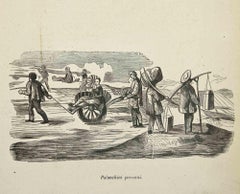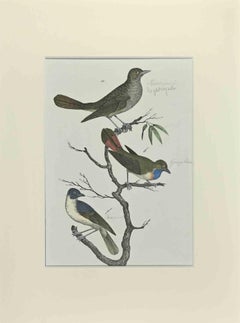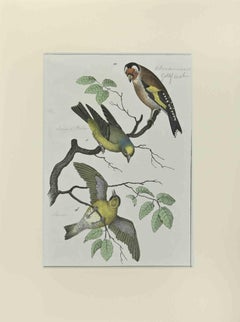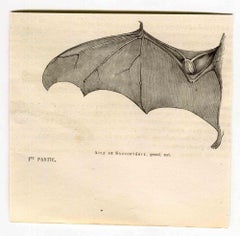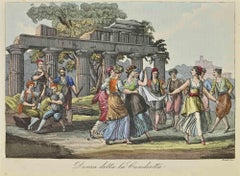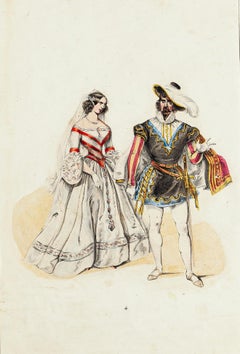Mid-19th Century Art
to
3,582
4,082
937
348
203
169
Overall Width
to
Overall Height
to
7,519
20,754
155,913
236,927
1,875
2,282
4,820
6,389
5,902
13,142
20,122
24,837
17,376
13,282
5,318
3,078
116
110
23
11
6
4
4
2
1
2,834
2,756
49
3,700
1,733
1,305
1,080
882
755
655
439
363
310
301
298
266
255
210
187
182
173
169
167
2,922
1,342
928
726
709
168
108
91
87
87
1,245
3,099
3,058
1,189
Period: Mid-19th Century
Customs - Persian Palanquins - Lithograph - 1862
Located in Roma, IT
Customs - Persian Palanquins is a lithograph on paper realized in 1862.
Titled on the lower.
The artwork belongs to the Suite Uses and customs of all the peoples of the universe: "...
Category
Modern Mid-19th Century Art
Materials
Lithograph
$135 Sale Price
25% Off
Nightingale - Etching by Johann Friedrich Naumann - 1840
Located in Roma, IT
Nightingale is a Etching hand colored realized by Gotthilf Heinrich von Schubert - Johann Friedrich Naumann, Illustration from Natural history of birds in pictures, published by Stut...
Category
Modern Mid-19th Century Art
Materials
Etching
$270 Sale Price
25% Off
Goldfintch - Etching by Johann Friedrich Naumann - 1840
Located in Roma, IT
Goldfintch is an Etching hand colored realized by Gotthilf Heinrich von Schubert - Johann Friedrich Naumann, Illustration from Natural history...
Category
Modern Mid-19th Century Art
Materials
Etching
$216 Sale Price
25% Off
Saccoptery's Wing - Lithograph by Paul Gervais - 1854
By Paul Gervais
Located in Roma, IT
Saccoptery's Wing is an original lithograph on ivory-colored paper, realized by Paul Gervais (1816-1879). The artwork is from The Series of "Les Trois Règnes de la Nature", and was p...
Category
Modern Mid-19th Century Art
Materials
Lithograph, Paper
$180 Sale Price
25% Off
Dance called the Candiotta - Lithograph - 1862
Located in Roma, IT
Dance called the Candiotta is a lithograph on paper realized in 1862.
The artwork belongs to the Suite Uses and customs of all the peoples of the universe: " History of the governme...
Category
Modern Mid-19th Century Art
Materials
Lithograph
$180 Sale Price
25% Off
Wedding Costume - Original Lithograph - Mid 19th Century
Located in Roma, IT
Wedding Costume ios an original lithograph hand-colored, realized by an anonymous artist of the XIX century
The state of preservation of the artwork is very good.
Sheet dimension: ...
Category
Mid-19th Century Art
Materials
Lithograph
$180 Sale Price
25% Off
Beach See Water Hubertus Van Hove Signed Paint Oil on table 19th Century Flemish
Located in Riva del Garda, IT
Hubertus van Hove (The Hague, 1814 - Antwerp, 1865)
- Signed H Van Hove and dated 1839 (bottom left) -
Coastal landscape with the beach of Scheveningen
Oil on panel
62 x 80 cm. - Framed 84 x 102 cm.
Provenance: Sotheby's, London, 19th Century European Paintings, Watercolours 12.03.1989, lot 11 (see details in photos)
The fine coastal view presented here is a work signed and dated by the Dutch landscape painter Hubertus van Hove (The Hague, 1814 - Antwerp, 1865), son of Bartholomeus van Hove (1790-1880). The work exhibits excellent taste and quality of execution, displaying a tender feeling for nature, romantic in character, and a mastery of drawing and a delicacy of chiaroscuro and harmony that is truly astonishing.
Although his major production was concentrated in works depicting domestic scenes, he was also an excellent landscape painter, a master in the use of light that he was able to infuse into his works through quick and precise brushstrokes, creating lively compositions such as the one in the catalogue.
Here we see a glimpse of one of the most fascinating beaches in the Netherlands, just a few kilometres from the city of The Hague, overlooking the North Sea. As early as the 17th century, this area became a popular seaside resort for entertainment, strolling and fish-buying among the citizens of nearby The Hague.
We are on a bright day on a wide sandy beach populated by numerous people who have come to breathe in the fresh sea air and are engaged in various activities. In the foreground we see a well-dressed couple on horseback, probably on a trip to the seaside, accompanied by a servant and a horseman, observing the catch lying on the beach by a fishing family. Behind them a carriage has stopped, the wealthy passenger chats with another middle-class couple, while a servant protects them from the sun with an umbrella.
The space is mainly occupied by the sky, criss-crossed by a few clouds and lit by a pale sun; typical is the clear, gentle light that gives a great sense of tranquillity to the composition.
The Dutch were the first to think of the sea in a ''modern'' sense, as a place of recreation, and already in the 17th century the beach of Scheveningen, famous because it was also the subject of paintings by Vincent van Gogh, was a place of pastime and outdoor activity.
Many Flemish authors, first and foremost Adriaen van de Velde...
Category
Impressionist Mid-19th Century Art
Materials
Oil
$14,743 Sale Price
20% Off
Gull - Etching by Johann Friedrich Naumann - 1840
Located in Roma, IT
Gull is an Etching hand colored realized by Gotthilf Heinrich von Schubert - Johann Friedrich Naumann, Illustration from Natural history of birds in pictures, published by Stuttgart ...
Category
Modern Mid-19th Century Art
Materials
Etching
Diseases of Uterus - Lithograph By Ottavio Muzzi - 1843
Located in Roma, IT
Diseases of Uterus is a lithograph hand colored by Ottavio Muzzi for the edition of Antoine Chazal, Human Anatomy, Printers Batelli and Ridolfi, 1843.
The work belongs to the Atlan...
Category
Modern Mid-19th Century Art
Materials
Lithograph
$180 Sale Price
25% Off
Diseases of Uterus - Lithograph By Ottavio Muzzi - 1843
Located in Roma, IT
Diseases of Uterus is a lithograph hand colored by Ottavio Muzzi for the edition of Antoine Chazal, Human Anatomy, Printers Batelli and Ridolfi, 1843.
The work belongs to the Atlan...
Category
Modern Mid-19th Century Art
Materials
Lithograph
$180 Sale Price
25% Off
Notre-Dame de Paris. Paper, watercolor, 26.5x18 cm
By Edward Nevil
Located in Riga, LV
Edward Nevil ( 1813 – 1901 )
Notre-Dame de Paris. Paper, watercolor, 26.5x18 cm
Category
Realist Mid-19th Century Art
Materials
Paper, Watercolor
$615 Sale Price
71% Off
Louis DAVID (1798-1849) Le Moulin La Butte aux Cailles, Paris, signed drawing
Located in Paris, FR
Louis-Alphonse DAVID (1798-1849)
Le Moulin de la Butte aux Cailles, Paris, (The Mill at la Butte aux Cailles)
signed lower left
Pencil and white chalk on paper
22,5 x 36 cm
Framed : 40,5 x 55 cm
Louis-Alphonse David is known for a relatively small body of work, including portraits and large compositions. In any case, in this work he shows a remarkable mastery of drawing, with particularly suggestive and subtle plays of light and shadow.
The Butte aux Cailles, now part of the 13th arrondissement of Paris, was a hill covered in meadows, vineyards and woods, built with several windmills and overlooking the river Bièvre. It was named after Pierre Caille...
Category
Romantic Mid-19th Century Art
Materials
Pencil, Chalk
'Courtesan and Young Man at Fuchu' Original Erotic Shunga Woodblock
Located in Milwaukee, WI
The present work is an excellent example of the erotic Shunga prints produced by Utagawa 'Ando' Hioshige and his school. Shunga imagery became especially widespread in Japan with the...
Category
Edo Mid-19th Century Art
Materials
Woodcut
Stargard - Original Lithograph Mid 19° Century
Located in Roma, IT
Stargard is a beautiful color lithograph on paper, printed by von Led Kempner and published by von Schaffstein and C. Koln, Rhein.
This modern artwork representing a view of the Po...
Category
Mid-19th Century Art
Materials
Lithograph
$180 Sale Price
25% Off
Testicular Diseases - Lithograph By Ottavio Muzzi - 1843
Located in Roma, IT
Testicular Diseases is a lithograph hand colored by Ottavio Muzzi for the edition of Antoine Chazal, Human Anatomy, Printers Batelli and Ridolfi, 1843.
...
Category
Modern Mid-19th Century Art
Materials
Lithograph
$180 Sale Price
25% Off
Intestinal Diseases - Lithograph By Ottavio Muzzi - 1843
Located in Roma, IT
Intestinal Diseases is a lithograph hand colored by Ottavio Muzzi for the edition of Antoine Chazal, Human Anatomy, Printers Batelli and Ridolfi, 1843.
The work belongs to the Atl...
Category
Modern Mid-19th Century Art
Materials
Lithograph
$180 Sale Price
25% Off
Indigenous People, Virginia, America, mid 19th century lithograph.
Located in Melbourne, Victoria
'Virginio - Sacerdote Virginio' / 'Gi' Indiant nella Virginia venerano il Fuoco''
Italian lithograph, c1841. Originally from 'Galleria universale di tutti i popoli del mondo' by Giu...
Category
Naturalistic Mid-19th Century Art
Materials
Lithograph
French Romantic School, 19th Century, Portrait of a man, oil on paper
Located in Paris, FR
French Romantic School, 19th Century
Portrait of a man, a selfportrait ?
oil on paper
17.5 x 12 cm oval
Framed under glass : 43 x 34.5 cm
This rather mysterious portrait is perhaps a self-portrait of the artist who painted it. This is suggested by the three-quarter pose and the gaze fixed on the viewer.
What this man seems to be staring at is himself.
Similarly, the model's appearance is reminiscent of the image of the romantic, bohemian, tortured artist. It's also very interesting that he used a range of dark colours to reinforce this idea of melancholy.
It has been suggested that this small oil on paper is close to the art of François Bonvin (1817-1887) and Théodule Ribot...
Category
Romantic Mid-19th Century Art
Materials
Oil
The Skeleton - Lithograph by Paul Gervais - 1854
By Paul Gervais
Located in Roma, IT
The Skeleton is an original lithograph on ivory-colored paper, realized by Paul Gervais (1816-1879). The artwork is from The Series of "Les Trois Règnes de la Nature", and was publis...
Category
Modern Mid-19th Century Art
Materials
Lithograph, Paper
$180 Sale Price
25% Off
Uses and Customs - Como Cathedral - Lithograph - 1862
Located in Roma, IT
Uses and Customs - Como Cathedral is a lithograph on paper realized in 1862.
The artwork belongs to the Suite Uses and customs of all the peoples of the universe: " History of the g...
Category
Modern Mid-19th Century Art
Materials
Lithograph
$135 Sale Price
25% Off
Shunga - Woodcut attr. Keisai Eisen - Mid-19th Century
By Keisai Eisen
Located in Roma, IT
Woodcut shunga print attributed to Keisai Eisen and realized in the early 19th century.
Good condition except for some signs of time.
Category
Modern Mid-19th Century Art
Materials
Woodcut
Landscape with Sheep & Cattle
Located in Milford, NH
A fine landscape with sheep and cattle by American artist George Loring Brown (1814-1889). Brown was born in Boston, Massachusetts, and was apprenticed to wood engravers and illustr...
Category
Mid-19th Century Art
Materials
Canvas, Oil
Uses and Customs - Republic of Cisalpina - Lithograph - 1862
Located in Roma, IT
Uses and Customs - Republic of Cisalpina is a lithograph on paper realized in 1862.
The artwork belongs to the Suite Uses and customs of all the peoples of the universe: " History o...
Category
Modern Mid-19th Century Art
Materials
Lithograph
$180 Sale Price
25% Off
The Radiant Prince Genji - Woodcut by Utagawa Kunisada-Mid 19th Century
Located in Roma, IT
The Radiant Prince Genji is an original artwork realized in the mid-19th Century by Utagawa Kunisada (1786-1865).
From the series "Sono sugata ukari utsushie" (Faithful Images of t...
Category
Modern Mid-19th Century Art
Materials
Woodcut
Wedding Procession - Original Etching by Jean Vandekerkhove - 1860
Located in Roma, IT
Wedding Procession is an original etching of paper realized by Jean Vandekerkhove in 1860 ca.
Good conditions except for some folding and stains.
Signed on the plate on the lower r...
Category
Mid-19th Century Art
Materials
Etching
Ancient Costumes - Lithograph - 1862
Located in Roma, IT
Ancient Costumes is a lithograph on paper realized in 1862.
The artwork belongs to the Suite Uses and customs of all the peoples of the universe: " History of the government, of the...
Category
Modern Mid-19th Century Art
Materials
Lithograph
$144 Sale Price
25% Off
Tamarin - Original Lithograph by Paul Gervais - 1854
By Paul Gervais
Located in Roma, IT
Tamarin is an original lithograph on ivory-colored paper, realized by Paul Gervais (1816-1879). The artwork is from The Series of "Les Trois Règnes de la Nature", and was published i...
Category
Modern Mid-19th Century Art
Materials
Lithograph
$315 Sale Price
25% Off
The Skeleton - Lithograph by Paul Gervais - 1854
By Paul Gervais
Located in Roma, IT
The Skeleton is an original lithograph on ivory-colored paper, realized by Paul Gervais (1816-1879). The artwork is from The Series of "Les Trois Règnes de la Nature", and was publis...
Category
Modern Mid-19th Century Art
Materials
Lithograph, Paper
$180 Sale Price
25% Off
Devil's Bridge - Lithograph - 1862
Located in Roma, IT
Devil's Bridge is a hand colored lithograph realized in 1864.
Good condition.
The artwork belongs to ththe Suite Uses and customs of all the peoples of the universe, or History of ...
Category
Modern Mid-19th Century Art
Materials
Lithograph
$198 Sale Price
25% Off
The Ram And Sheep - Original Lithograph by Paul Gervais - 1854
By Paul Gervais
Located in Roma, IT
The Ram And Sheep is an original colored lithograph on ivory-colored paper, realized by Paul Gervais (1816-1879). The artwork is from The Series of "Les Trois Règnes de la Nature", a...
Category
Modern Mid-19th Century Art
Materials
Lithograph
$315 Sale Price
25% Off
Portrait - Lithograph by Auguste Raffet - 1843
Located in Roma, IT
Portrait is a Lithograph realized by Auguste Raffet (1804-1860).
Good condition on a yellowed paper.
Hand signed and dated by the artist on the lower right corner.
Denis Auguste M...
Category
Modern Mid-19th Century Art
Materials
Lithograph
Uses and Customs - Horse Mounting Method - Lithograph - 1862
Located in Roma, IT
Uses and Customs - Horse Mounting Method is a lithograph on paper realized in 1862.
The artwork belongs to the Suite Uses and customs of all the peoples o...
Category
Modern Mid-19th Century Art
Materials
Lithograph
$162 Sale Price
25% Off
Uses and Customs - Dresses in Athens - Lithograph - 1862
Located in Roma, IT
Uses and Customs - Dresses in Athens is a lithograph on paper realized in 1862.
The artwork belongs to the Suite Uses and customs of all the peoples of the universe: " History of th...
Category
Modern Mid-19th Century Art
Materials
Lithograph
$162 Sale Price
25% Off
19th century English coastal sea scene with warships, fishing boats and yachts
Located in Woodbury, CT
Alfred Vickers Senior (1786–1868)
Shipping off the Coast, oil on canvas, circa 1860, signed lower left
This lively coastal scene by Alfred Vickers Senior, painted circa 1860, reveal...
Category
Victorian Mid-19th Century Art
Materials
Oil, Canvas
Persian Coins - Lithograph - 1862
Located in Roma, IT
Customs -Persian Coinsin China is a lithograph on paper realized in 1862.
Titled on the lower.
The artwork belongs to the Suite Uses and customs of all the peoples of the universe:...
Category
Modern Mid-19th Century Art
Materials
Lithograph
$162 Sale Price
25% Off
Uses and Customs - Map of Churches - Lithograph - 1862
Located in Roma, IT
Uses and Customs - Map of Churches is a lithograph on paper realized in 1862.
The artwork belongs to the Suite Uses and customs of all the peoples of the universe: " History of the ...
Category
Modern Mid-19th Century Art
Materials
Lithograph
$162 Sale Price
25% Off
Ancient View of Pont Rouge in Saint Petersburg - Original Lithograph - 1850s
Located in Roma, IT
Ancient View of Pont Rouge in Saint Petersburg is an original modern artwork realized in France in the first half of the 19th Century.
Original B/W Lithograph on Ivory Paper.
Insc...
Category
Old Masters Mid-19th Century Art
Materials
Lithograph
Valletta From the Quarantine Harbour - Original Lithograph - Early-19th Century
Located in Roma, IT
Valletta From the Quarantine Harbour is an original modern artwork realized in Italy in the first half of the 19th Century.
Original Lithograph on Ivory Paper.
Inscripted in capit...
Category
Modern Mid-19th Century Art
Materials
Lithograph
William Shakespeare's "All's Well That Ends Well"after Wheatley- Etching - 1850s
Located in Roma, IT
William Shakespeare's "All's Well That Ends Well" after Wheatley is an etching realized in the 1850s.
Titled and text from play on the lower.
Good conditions with foxing.
This pri...
Category
Modern Mid-19th Century Art
Materials
Etching
$216 Sale Price
25% Off
Paphy - Original Woodcut Print - Mid 19th Century
Located in Roma, IT
Paphy is an original modern artwork realized in Germany in the Mid-19th Century.
Original B/W woodcut print on Ivory Paper.
Inscripted on the Upper margin in Capital Letters: Paph...
Category
Modern Mid-19th Century Art
Materials
Woodcut
$180 Sale Price
25% Off
Antique MUSEUM 1890’s CUBAN Painting, “The ARTIST GRAND CHILDREN”
Located in New York, NY
For sale we have this large portrait depicting two young girls in white dresses, standing side by side and posing for the painting. Painted by John Peoli and the Girls happen to be J...
Category
Realist Mid-19th Century Art
Materials
Oil
French Romantic school, View of a citadel, pen and watercolor
Located in Paris, FR
French Romantic school, 19th century
View of a citadel
Pen and ink, watercolor and heightenings of white gouache on brown paper
18 x 29.5 cm
In good condition, some stains and traces...
Category
Romantic Mid-19th Century Art
Materials
Ink, Watercolor
$391 Sale Price
30% Off
WAPPERS Painting Belgian 19th romantic Oil on panel wood mandoline woman player
Located in PARIS, FR
Gustave WAPPERS (Attributed to) Anvers, 1803 - Paris, 1874 Oil on panel Trace of monogram lower right 42.5 x 31.5 cm (59.5 x 49.5 cm with the frame) XIXth century frame in carved woo...
Category
Romantic Mid-19th Century Art
Materials
Oil
$1,922 Sale Price
20% Off
Caribbean Indigenous People / Orinoco, America, mid 19th century lithograph.
Located in Melbourne, Victoria
'Famiglia di Karaibi' / 'Tartarnughe deponenti le uova alle sponde dell' Orenoko''
Italian lithograph, c1841. Originally from 'Galleria universale di tutti i popoli del mondo' by Gi...
Category
Naturalistic Mid-19th Century Art
Materials
Lithograph
English 19th century portrait painting of a Pointer dog in a woodland landscape
Located in Bath, Somerset
A black pointer in a woodland landscape by John Frederick Herring Senior, circa 1830. Oil on canvas in a giltwood frame.
Provenance:
Arthur Ackerman and Son
Frost and Reed
Blains, Bruton Place, London
John Frederick Herring, born in London in 1795, was the son of a London merchant of Dutch parentage, who had been born overseas in America. The first eighteen years of Herring's life were spent in London, where his greatest interests were drawing and horses. In 1814, at the age of 18, he moved to Doncaster in the north of England, and by 1815, had married Ann Harris. His sons John Frederick Herring Jr., Charles Herring, and Benjamin Herring...
Category
Victorian Mid-19th Century Art
Materials
Canvas, Oil
"La Danza", Grande scultura in Marmo bianco di Carrara XIX secolo
Located in Pistoia, IT
Antonio-Giovanni Lanzirotti, "La Danza", grande scultura in marmo bianco di Carrara, firmata AG Lanzirotti sulla base.
Antonio Giovanni Lanzirotti, nato a Palermo il 9 maggio 1839 e...
Category
Italian School Mid-19th Century Art
Materials
Marble
Rabelais - How Panurge Speaks To The Sibyl Of Panzoust
Located in PARIS, FR
Jules-Arsène Garnier (1847 - 1889) Scene from Rabelais' Third Book, How Panurge Speaks to the Sibyl of Panzoust
Oil on canvas
38.5 x 46.5 cm (67 x 74.8 cm with frame)
Signed lower r...
Category
Mid-19th Century Art
Materials
Canvas, Oil
Charles Emile Jacque (Paris 1813 - 1894) Dog in a doghouse, signed drawing
Located in Paris, FR
Charles Emile Jacque (1813-1894)
Dog in a doghouse
Monogrammed "C. J. "lower right
Pencil on paper
17 x 13 cm
Mark of the Collection of Doctor Albert Finot "AF" (Lugt 3627) lower lef...
Category
Romantic Mid-19th Century Art
Materials
Carbon Pencil
Richard Bankes Harraden: St John's College, Oxford oil painting
Located in London, GB
To see our other views of Oxford and Cambridge, scroll down to "More from this Seller" and below it click on "See all from this Seller" - or send us a message if you cannot find the view you want.
Richard Bankes Harraden...
Category
Realist Mid-19th Century Art
Materials
Oil, Board
Utagawa Hiroshige -- Looking toward Ikenohata from the Hill of the Yushima Tenji
Located in BRUCE, ACT
Utagawa Hiroshige (Ando Hiroshige)
Looking toward Ikenohata from the Hill of the Yushima Tenjin Shrine (Yushima Tenjin sakaue yori Ikenohata o miru zu), from the series Famous Places...
Category
Mid-19th Century Art
Materials
Woodcut
Utagawa Kuniyoshi -- Feast of the Seven Herbs (the Five Festivals 五節句)
Located in BRUCE, ACT
Utagawa Kuniyoshi
Title Feast of the Seven Herbs ( the Five Festivals 五節句 )
Size Oban
Year 1843~1847
FREE SHIPPING
Category
Mid-19th Century Art
Materials
Woodcut
$406 Sale Price
30% Off
c.1840 Oil - The Lady Of The Estate
Located in Corsham, GB
A truly unique and eye catching 19th Century portrait, showing a striking woman in a vibrant red shawl and elaborate lace bonnet. The rich tapestry on the sleeves of her shawl, the d...
Category
Mid-19th Century Art
Materials
Oil
$1,317 Sale Price
20% Off
At the Shore, Victor Huguet, 19th Century Orientalist Landscape , Oil on Canvas
Located in Jacksonville, FL
With an expert command of light and movement, Victor Huguet’s At the Shore transports the viewer to a coastal expanse where a group of Arab horsemen and figures gather against a stun...
Category
Romantic Mid-19th Century Art
Materials
Oil
William Williams (1808-1895) - 1841 Oil, Plymouth Fisherfolk
Located in Corsham, GB
A fine oil study by well listed artist William Williams of Plymouth. The scene depicts a mother and child untangling nets on a beach in Plymouth. The artist catches the rugged Devons...
Category
Mid-19th Century Art
Materials
Oil
$760 Sale Price
20% Off
19th Century Landscape Oil Painting - Deer by the Banks of a Lake
By Jacob Thompson
Located in London, GB
Jacob THOMPSON (1806 – 1879)
Deer by the Banks of a Lake
1842
oil on canvas
18.9 x 27.6 inches;
22.5 x 31 inches Inc. frame
Jacob Thompson (1806–1879) was an English landscape-pa...
Category
Old Masters Mid-19th Century Art
Materials
Oil
Chickens in the Farmyard in pair
By Claude Guilleminet
Located in Saint-Ouen, FR
GUILLEMINET Claude (1821-1860)
Chickens in the Farmyard
Oils on wood panels in pair signed low
New golden frames
Dim wood panel (each) : 27 X 20 cm
Dim frame (each) : 47 X 40 cm
GU...
Category
Academic Mid-19th Century Art
Materials
Oil
Yport - The cliff of Amont in Normandy
Located in BELEYMAS, FR
Alexandre DEFAUX
(1826, Bercy - 1900, Melun)
Yport, the Amont Cliff
Oil on panel
H. 59.5 cm; W. 38.5 cm
Signed and located lower right
A student of Corot, Alexandre Defaux was a fai...
Category
French School Mid-19th Century Art
Materials
Oil, Wood Panel
French School 19th century, Set of nine humoristic drawings, pencil on paper
Located in Paris, FR
France, 19th century
Set of nine humoristic drawings, various subjects in the same mount
Black pencil, for some of them with highlights of white gouache
various dimensions : 6 x 5.5 ...
Category
Romantic Mid-19th Century Art
Materials
Carbon Pencil
$382 Sale Price
25% Off
David Roberts “Approach of the Simoon - Desert of Geezah” “
Located in San Francisco, CA
David Roberts: 1796-1864. Very important and well Listed 19th century Scottish artist. He has had Auction results for paintings in excess of $1 million. Nevertheless, he is most reco...
Category
Realist Mid-19th Century Art
Materials
Lithograph
Girolamo Tubino After Raffaello, Sanzio Da Urbino La Velata
Located in Cheltenham, GB
This fine mid-19th-century watercolour by Italian artist Girolamo Tubino (1805-1879) is after ‘La Velata’ (Woman with a Veil) by Raphael (1483-1520),...
Category
Old Masters Mid-19th Century Art
Materials
Paper, Watercolor
Recently Viewed
View AllMore Ways To Browse
1953 Watch
Wood Carving Portrait
18th Century Venetian Paintings
1980 Japanese Poster
18th Century Dog Paintings
18th Ruins Painting
1880 Portrait Of Women
1993 Kelly
18th Century Hunting Paintings
Black African Bust
1790 Oil Painting
19th Century French Female Portraits
Soldier Horse Painting
1918 Dress
1940s Paintings Florida
Young Child Nude
1940s Male Nude
19th Century Provincial Oil Painting
